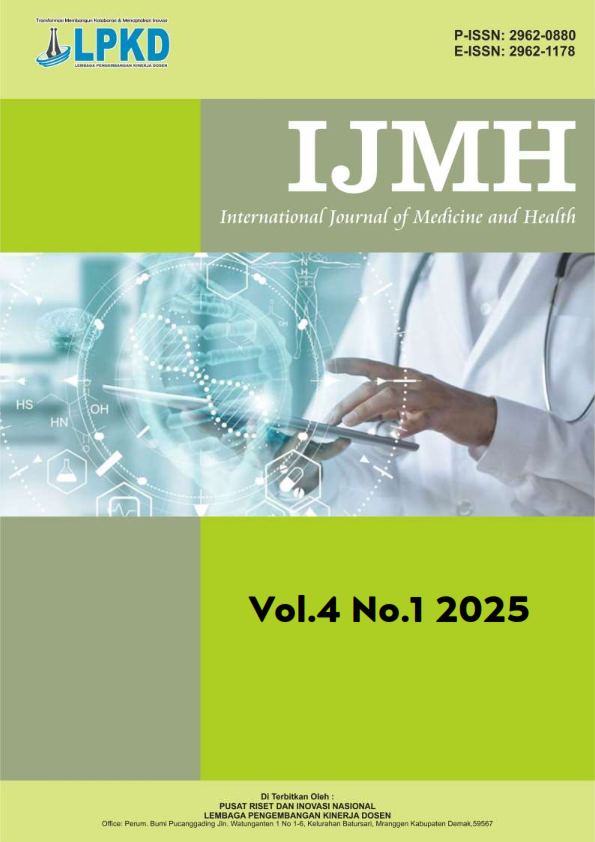Dengue Hemorrhagic Fever (DHF) Incidence in the Aur Duri Health Center Work Area in 2024
DOI:
https://doi.org/10.55606/ijmh.v4i1.5603Keywords:
Behavioral Factors, Characteristic Factors, Dengue Hemorrhagic Fever, DHFAbstract
Background: Dengue Hemorrhagic Fever is a health problem that is very rapidly transmitted, especially in endemic areas in Indonesia, one of which is in Jambi City. Indicators of DHF control activities are measured by the incidence rate per 100,000 population (IR) and the mortality rate (CFR). IR in 2018 was 23.28 per 100,000 population and CFR in 2018 was 0.36%. Although there has been a decrease in CFR every year, the incidence of DHF cases and deaths due to DHF still occur every year in 11 districts/cities in Jambi Province. Method: This study aims to analyze the determinants of the incidence of Dengue Hemorrhagic Fever (DHF) in the Aur Duri Health Center Working Area in 2024. The case control study design, the study was conducted from February to September 2024. This study used primary data from 2024 with a sample of 68 respondents. The variables used are Gender, Residential Density, House Condition, Hanging Clothes Habits, 3M Plus Behavior and Cleaning Water Reservoirs. Conclusion: This study found that the variables related to the incidence of DHF in the Aur Duri Health Center work area in 2024 were the variable of hanging clothes ( p-value = 0.012); 3M Plus Behavior ( p-value = 0.001); and the habit of cleaning water reservoirs ( p-value = 0.007). For the community, it is necessary to always increase self-protection efforts and for the Aur Duri Health Center, it can provide training or movements to eradicate or stop the transmission of DHF.
References
A global brief on vector-borne diseases. (n.d.). 1–56.
Benyamin, A. E., & Nisari, N. (2023). The relationship between 3M Plus behavior and the incidence of dengue hemorrhagic fever (DHF) at Umbulharjo 1 Health Center, Yogyakarta City, Special Region of Yogyakarta in 2022/2023. Jurnal Kesehatan Masyarakat, 8(3), 255–267.
Fever, K., Dengue, B., In, D. B. D., & Work, W. (2022). Indonesian community health journal Vol 18 no 1 March 2022. Indonesian Community Health Journal, 18(1), 406–415.
Hikmawa, I., Km, S., Epid, M. K., Huda, S., & Si, S. (2021). The role of mosquitoes as vectors of dengue hemorrhagic fever (DHF) through transovarial transmission. Jurnal Entomologi Kesehatan, 5(2), 112–120.
Idris, E. A., & Zulaikha, F. (2021). Relationship of gender to the incidence of DHF in children at RA AL Kamal 4 Kindergarten in the Bukuan Area of Samarinda City. Jurnal Epidemiologi Kesehatan Masyarakat, 2(3), 1592–1598.
Ilham, M., Latif, M., Anwar, M. C., & Cahyono, T. (2019). The epidemiology of dengue fever in Banyumas Regency. Jurnal Kesehatan Indonesia, 40(4), 179–187.
Implementation, A., Control, M., & Fever, V. (2024). VISA: Journal of Visions and Ideas. VISA: Journal of Visions and Ideas, 3(3), 473–482.
Kementerian Kesehatan Republik Indonesia. (2017). Research methodology.
Kementerian Kesehatan Republik Indonesia. (2022). Indonesia health profile 2022.
Palupy, R. Q., & Universitas Jambi. (2021). Public health study program, Faculty of Medicine and Health Sciences, University of Jambi.
Prasetyo, E., Wahyudi, A., & M, N. S. (2023). Factors affecting dengue fever incidence. Journal of 'Aisyiyah Palembang, 8, 203–222.
Public Health Study Program, University of Muhammadiyah. (2020). Study on dengue fever prevention methods.
Saputra, A. U., Ariyani, Y., & Dewi, P. (2023). Family habits towards dengue fever disease. Jurnal Kesehatan Keluarga, 8, 283–292.
Sekolah Tinggi Ilmu Kesehatan Bina Husada Palembang. (2021). Public health study program.
Susmaneli, H. (2011). Factors associated with the incidence of dengue hemorrhagic fever in hospitals, Rokan Hulu Regency. Jurnal Kesehatan Masyarakat, 1(5), 149–154.
Downloads
Published
Issue
Section
License
Copyright (c) 2025 International Journal of Medicine and Health

This work is licensed under a Creative Commons Attribution-ShareAlike 4.0 International License.






